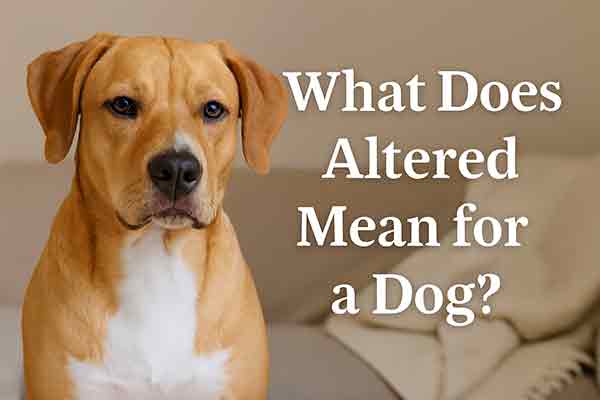What Does Altered Mean for a Dog? | Spaying, Neutering & Pet Health Guide
Table of Contents
- Introduction
- What Does ‘Altered’ Mean in Dogs?
- Why Altering a Dog Is Important
- Benefits of Spaying or Neutering
- Potential Risks and Considerations
- Best Age to Alter a Dog
- Common Myths About Spaying and Neutering
- Recovery and Aftercare Post Surgery
- Cost and Resources for Altering Your Dog
- Conclusion
Introduction
If you’ve adopted a dog or visited an animal shelter, you may have come across the term “altered” used in medical or adoption forms. But what does altered mean for a dog? In short, it means the dog has been surgically sterilized—either spayed (for females) or neutered (for males). This procedure has significant implications for your pet’s health, behavior, and the broader animal community. In this article, we’ll explore the full meaning of “altered,” its benefits, potential drawbacks, and what to expect if you’re considering this for your furry friend.
What Does ‘Altered’ Mean in Dogs?
The term “altered” refers to a dog that has undergone a surgical procedure to remove its reproductive organs. In males, this is called neutering (removal of the testicles). In females, it’s called spaying (removal of the ovaries and usually the uterus).
Veterinarians may use the term “altered” on medical records or adoption paperwork to quickly indicate that a dog can no longer reproduce.
Why Altering a Dog Is Important
Altering is not just a personal choice—it’s often considered a responsible act of pet ownership. Millions of unwanted dogs end up in shelters every year, many of whom are euthanized. Spaying or neutering helps reduce pet overpopulation and ensures a healthier pet population overall.
Additionally, altering your dog can prevent certain diseases and unwanted behaviors, leading to a better quality of life for both pets and their owners.
Benefits of Spaying or Neutering
- Reduces risk of certain cancers: Spaying reduces the risk of mammary tumors; neutering prevents testicular cancer.
- Improved behavior: Can reduce marking, roaming, mounting, and aggression linked to hormones.
- Prevents unwanted litters: Avoids unplanned puppies and helps curb shelter overcrowding.
- Less risk of infections: Spayed females avoid uterine infections (pyometra), which can be life-threatening.
- Longer lifespan: Studies show altered dogs often live longer, healthier lives.
Potential Risks and Considerations
Though generally safe, altering is a surgical procedure and comes with some risks:
- Potential for weight gain if diet and exercise aren’t adjusted
- Surgical complications, though rare with proper care
- Some evidence of joint issues when altered too young (especially in large breeds)
- Temporary discomfort and recovery period
It’s important to discuss the timing and pros/cons with your veterinarian, especially if your dog has breed-specific health concerns.
Best Age to Alter a Dog
Veterinarians typically recommend altering between 6 to 12 months of age, though some shelters may perform it as early as 8 weeks in healthy puppies. The optimal timing may vary depending on your dog’s breed, size, and overall health.
For large or giant breeds, some vets recommend waiting until 12–18 months to allow for full bone development, minimizing the risk of orthopedic issues.
Common Myths About Spaying and Neutering
- Myth: “My dog will get fat after being altered.”
Truth: Weight gain is usually due to reduced activity or overfeeding—not the procedure itself. - Myth: “It changes their personality.”
Truth: Hormone-driven behaviors may decrease, but your dog’s core temperament won’t change. - Myth: “Females should have one litter first.”
Truth: There are no proven health benefits to allowing a dog to have a litter before being spayed.
Recovery and Aftercare Post Surgery
Most dogs recover quickly from spay/neuter surgery. Here’s how to help your pet heal smoothly:
- Limit activity for 7–10 days
- Use an e-collar to prevent licking or biting the incision
- Monitor the incision site for swelling, redness, or discharge
- Follow your vet’s pain management and medication instructions
- Keep your dog calm and comfortable
Cost and Resources for Altering Your Dog
The cost of spaying or neutering can range from $50 to $300 depending on your location, vet, and your dog’s size and gender. Some animal shelters, rescue groups, and veterinary schools offer low-cost or free clinics.
Resources to explore include:
- ASPCA Low-Cost Spay/Neuter Programs
- Local humane societies
- City or county animal control agencies
- Pet insurance or veterinary wellness plans
Conclusion
So, what does altered mean for a dog? It simply means the dog has been spayed or neutered—a decision that can lead to a longer, healthier life and contribute to solving the broader issue of pet overpopulation. While it’s important to consider the timing and individual factors for each dog, altering is widely considered one of the most responsible actions a pet owner can take.
Need more help navigating pet healthcare choices? Explore our blog for vet-approved advice, pet parenting tips, and answers to your biggest canine questions.







